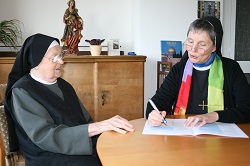Women get sicker but men die quicker disproved
A few years back, a research team based at the Vienna Institute of Demography (VID) of the Austrian Academy of Sciences decided to tackle the so-called gender and health paradox. This is the seemingly contradictory observation that women live longer than men but experience worse health. The idea that ‘women get sicker but men die quicker’ gained currency during the 1960s to the 1980s but has never been properly explained. Thus HEMOX project, led by Marc Luy, project coordinator and head of the health and longevity research group at VID, was born. ‘This seems contradictory because if one population lives longer you would expect them to be healthier,’ says Dr Luy. ‘But I never believed in the paradox as I was sure there must be a logical explanation.’ He suspected women may experience worse health precisely because they live longer rather than in spite of it and decided to find a way to test this hypothesis. The team did so by looking at the relationship between health and mortality among Catholic nuns and monks from Austria and Germany and comparing this to the general population. Monks live longer Studying cloister populations provides demographers with valuable insights as they provide a rare example of an environment where men and women live very similar lives, thus making comparisons possible. ‘From our previous studies we know monks live on average 4–5 years longer than ordinary men but nuns enjoy a much smaller advantage over ordinary women,’ says Dr Luy. Previous research tended to define what constitutes health in very general terms, but the HEMOX team decided to distinguish between the incidence of chronic diseases such as arthritis or asthma and ones which are life-threatening such as heart disease or forms of cancer. ‘We compared members of the same sex — those who live in cloister to those who don’t — to test the hypothesis that there could be a link between health and longevity. If this is true, then the male order members should live longer but spend longer in ill health than ordinary men, but with females there would not be much difference between the two groups,’ says Dr Luy, ‘so we collected the health and mortality data and this did confirm the hypothesis.’ Strong link found The team extended the experiment to 30 other sub-groups of the general population. It compared groups who typically show significant differences in life expectancy, such as people with higher or lower levels of education, people who are obese or underweight, or people with white-collar or manual jobs. ‘We found a very strong positive association between life expectancy and the number of life years spent with chronic diseases and a negative association between life expectancy and life years spent with life-threatening diseases,’ says Dr Luy. ‘This demonstrates there is a strong link between health and longevity. When we did the same for the gender gaps in health and longevity, we found the same associations.’ The results indicate that there is a logical explanation for the so-called gender health paradox. Women do get sicker in that they typically suffer from more chronic diseases than men. However this is not because they are women but because they live longer. These new insights on gender, health and ageing could be relevant not only for public health policy but for anyone with an interest in the mechanisms behind healthy ageing.
Keywords
HEMOX, gender, longevity, healthy ageing, epidemiology, nuns, monks, mortality



